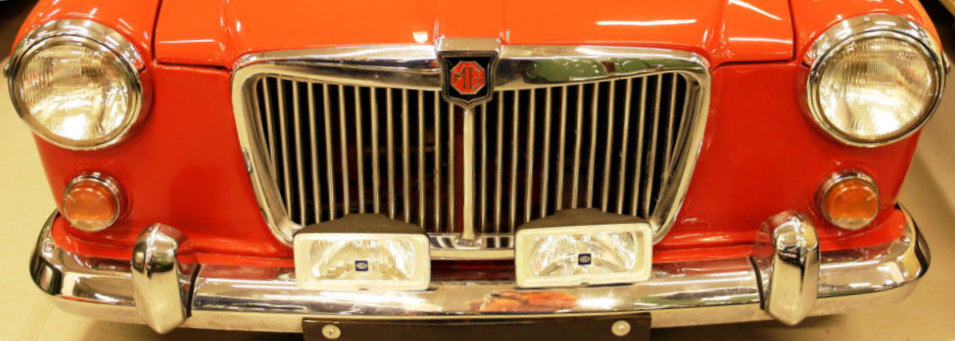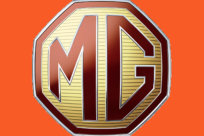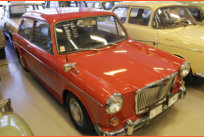



In 1964 the 1100 was Wheels magazine's Car of the Year.

MG 1100 - 64
The BMC ADO16 (Amalgamated Drawing Office project
number 16) is a family of economical small family cars
built by the British Motor Corporation (BMC) and, later,
British Leyland. It was launched in 1962 and for most of
the next decade the ADO16 was consistently the UK's
best-selling car.
Although most of the cars were manufactured in England, they were also built in Spain by Authi, in Italy by Innocenti and at the company's own plant in Belgium. It was the basis for locally adapted similar cars manufactured in Australia and South Africa. Various versions including Austin, Morris, MG, Wolseley and Riley were assembled in New Zealand from CKD kits from 1963 until the final Austin/Morris versions were replaced by the Allegro in 1975. The vehicle was launched as the Morris 1100 on 15 August 1962. The range was expanded to include several rebadged versions, including the twin-carburettor MG 1100, the Vanden Plas Princess (from October 1962), the Austin 1100 (August 1963), and finally the Wolseley 1100 (1965) and Riley Kestrel (1965). The Morris badged 1100/1300 gave up its showroom space to the Morris Marina in 1971, but Austin and Vanden Plas versions remained in production in the UK until June 1974. The estate version followed in 1966, called Countryman in the Austin version and Traveller in the Morris one, continuing the established naming scheme. The Austin 1100 Countryman appeared in the legendary "Gourmet Night" episode of Fawlty Towers, in which the short-tempered owner of Fawlty Towers Basil Fawlty (John Cleese) gave it a "damn good thrashing". This episode was first shown in October 1975.Design and development
The ADO16 (Amalgamated Drawing Office project number 16) was designed by Alec Issigonis. Following his success with the Mini, Issigonis set out to design a larger and more sophisticated car which incorporated more advanced features and innovations. In common with the Mini, the ADO16 was designed around the BMC A-Series engine, mounted transversely and driving the front wheels. As well as single piston swinging caliper disc brakes at the front, which were not common on mass-produced cars in the early 1960s, the ADO16 featured a Hydrolastic interconnected fluid suspension system designed by Alex Moulton. The mechanically interconnected Citroen 2CV suspension was assessed in the mid-1950s by Alec Issigonis and Alex Moulton (according to an interview by Moulton with CAR magazine in the late 1990s), and was an inspiration in the design of the Hydrolastic suspension system for the Mini and Austin 1100, to try to keep the benefits of the 2CV system (ride comfort, body levelling, keeping the roadwheel[clarification needed] under good control and the tyre in contact with the road), but with added roll stiffness that the 2CV lacked. Pininfarina, the Italian styling studio which had worked with BMC before on the Austin A40 Farina, was commissioned to style the car. ADO16 had comparable interior space to the larger Ford Cortina. BMC engineer Charles Griffin took over development work from Issigonis at the end of the 1950s while Issignois completed work on the Mini. Griffin ensured the 1100 had high levels of refinement, comfort and presentation. Griffin would later have overall responsibility for the Princess, Metro, Maestro and Montego ranges. The ADO16 range sold 2.1 million units between 1962 and 1974.Mark I (1962–67)
The original Mark I models were distinctive for their use of a Hydrolastic suspension. Marketing material highlighted the spacious cabin when compared to competitor models which in the UK by 1964 included the more conservatively configured Ford Anglia, Vauxhall Viva HA and BMC's own still popular Morris Minor. The Mark I Austin / Morris 1100 was available, initially, only as a four-door saloon. In March 1966 a three-door station wagon became available, badged as the Morris 1100 Traveller or the Austin 1100 Countryman. Domestic market customers looking for a two-door saloon would have to await the arrival in 1967 of the Mark II version, although the two-door 1100 saloon had by now been introduced to certain oversea markets, including the USA where a 2-door MG 1100 was offered. An Automotive Products (AP) four-speed automatic transmission was added as an option in November 1965. In order to avoid the serious levels of power loss then typical in small-engined cars with automatic transmission the manufacturers incorporated a new carburettor and a higher compression ratio in the new 1965 automatic transmission cars: indeed a press report of the time found very little power loss in the automatic 1100, though the same report expressed the suspicion that this might in part reflect the unusually high level of power loss resulting from the way in which the installation of the transversely mounted "normal" manual gear box had been engineered.
1964
Engine 1098 cc 4 cylinders Power 55 HP Top speed 130 km/h Lenght/width 3,73 m/1,53 m Weight 840 kg The collections MG 1100 was bought from Sweden.

Photos mainly by Matti Kreivilä. Historical facts and technical details of the vehicles provided by Wikipedia. Movies YouTube.



- Decade of 60's
- Austin 850 Pickup - 1962
- Chaika Tshaika 13 GAZ - 1962
- Citroen 2CV - 1961
- DKW Junior - 1961
- Fiat 1100 - 1963
- Ford Taunus 12M - 1961
- GLAS 1204 - 1963
- MG 1100 - 1964
- Moskvich 407 - 1961
- Nagetusch caravan - 1961
- NSU Printz 4 - 1961
- Opel Kadett A - 1964
- Panhard PL17 - 1961
- Peugeot 404 - 1962
- Renault Dauphine - 1965
- Simca Aronde P60 - 1960
- Simca 1000 - 1966















